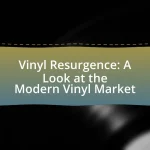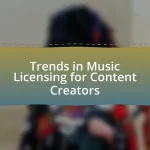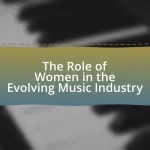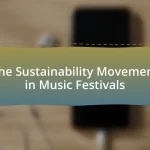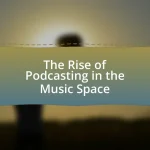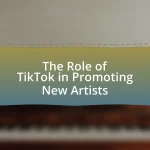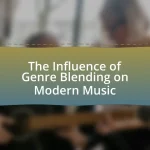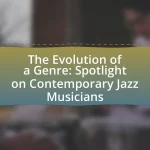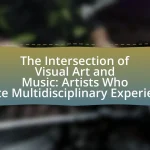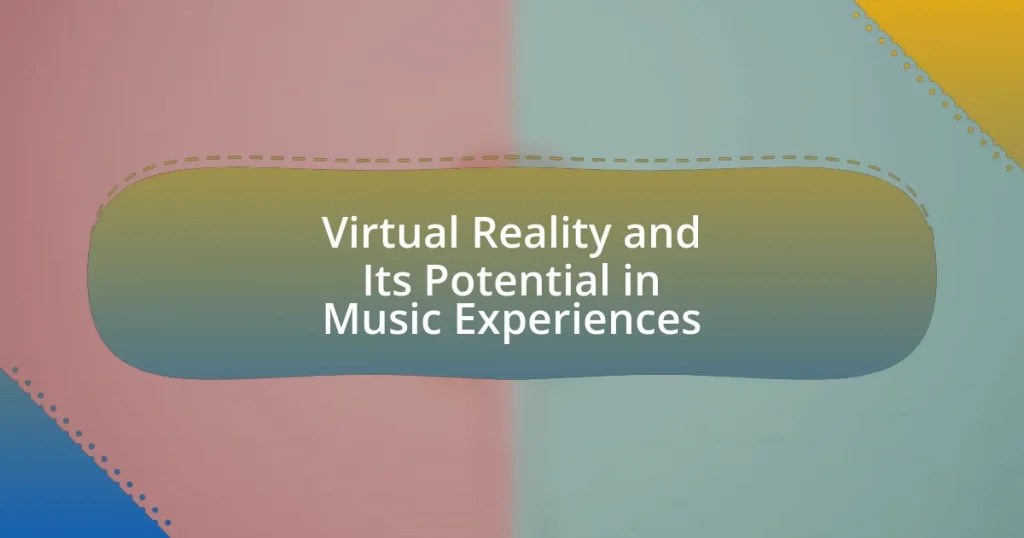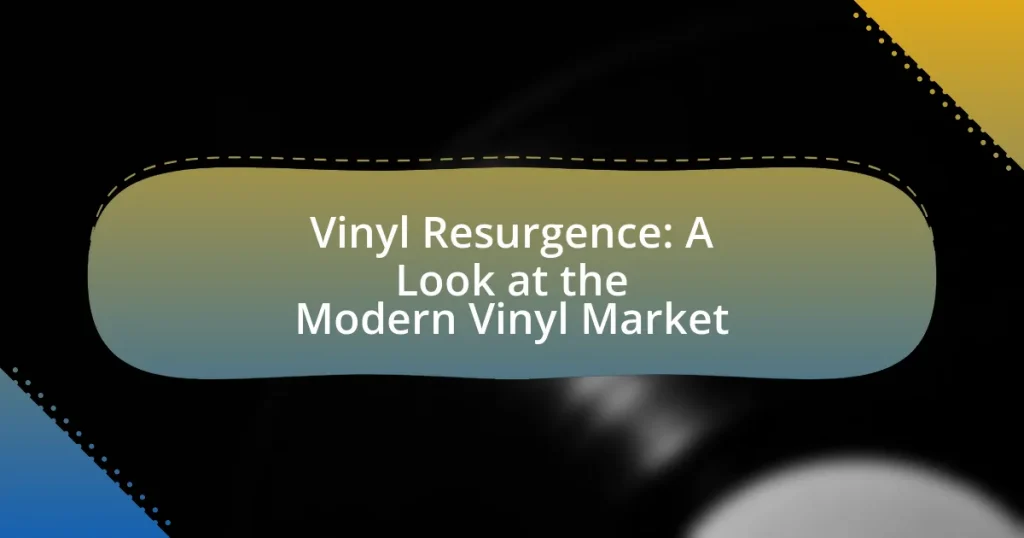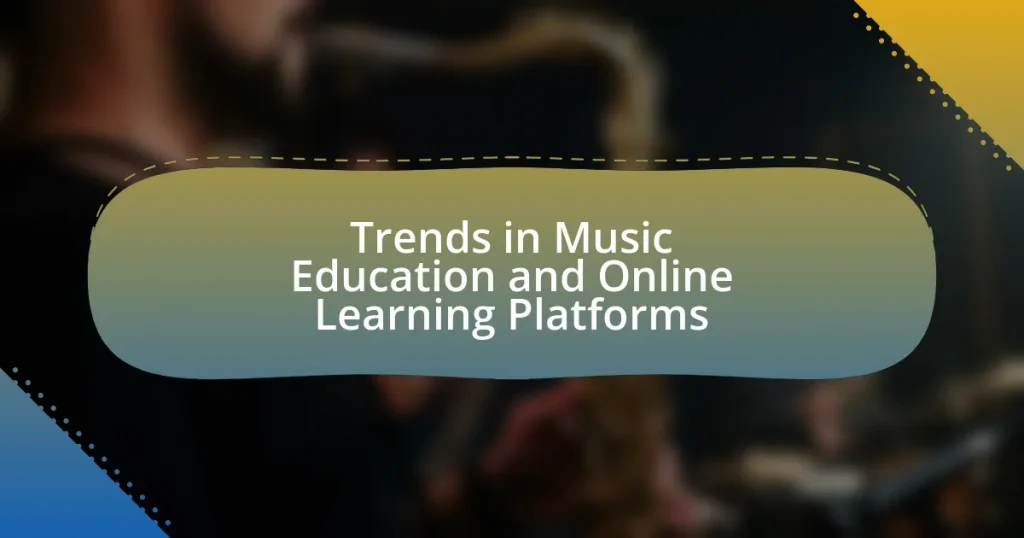The article examines the legacy of protest music, highlighting its historical significance and evolution from the 1960s to contemporary times. It discusses how artists like Bob Dylan and Joan Baez laid the groundwork for social change through their music, while modern musicians such as Kendrick Lamar and Billie Eilish continue to address pressing issues like systemic racism and climate change. The piece also explores the impact of historical events on protest music themes, the role of various genres in amplifying marginalized voices, and the significance of social media in promoting these messages today. Additionally, it emphasizes how listeners can engage with and support protest music, fostering community and activism around social justice issues.
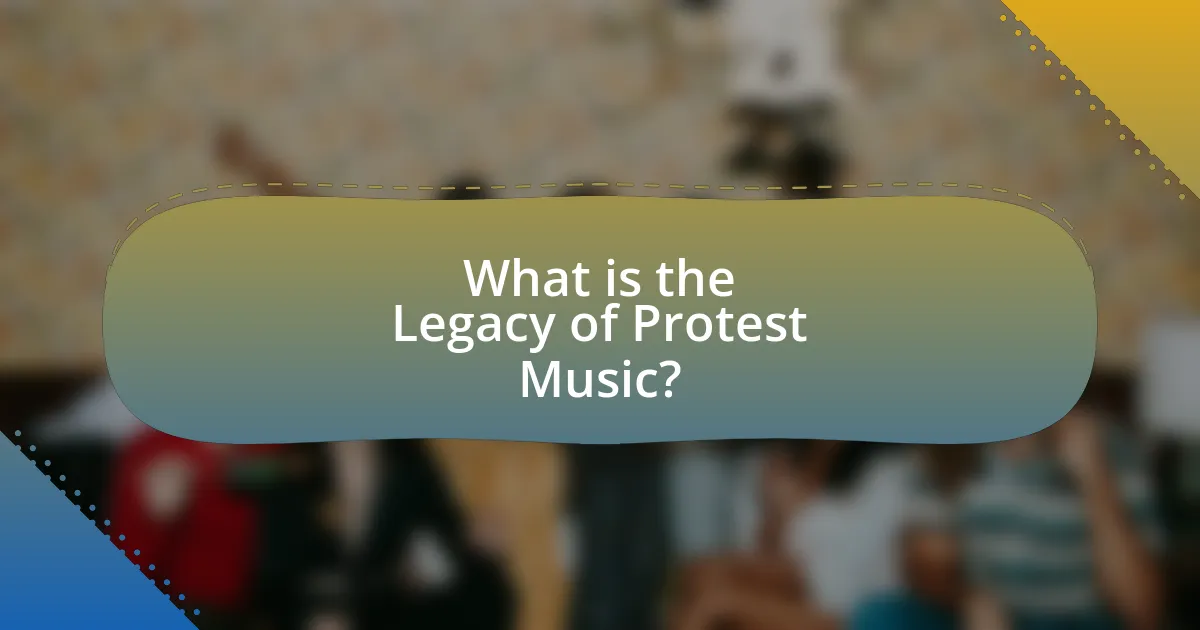
What is the Legacy of Protest Music?
The legacy of protest music lies in its ability to inspire social change and amplify marginalized voices. Historically, protest music has played a crucial role in movements such as the Civil Rights Movement in the 1960s, where artists like Bob Dylan and Joan Baez used their platforms to address issues of racial injustice and inequality. This genre continues to resonate today, as contemporary artists like Kendrick Lamar and Billie Eilish address current social issues, including systemic racism and climate change, through their music. The enduring impact of protest music is evident in its capacity to unite communities, provoke thought, and motivate action, making it a vital tool for advocacy and resistance throughout history.
How has protest music evolved over the decades?
Protest music has evolved significantly over the decades, transitioning from folk and blues in the 1960s to a diverse range of genres including hip-hop, punk, and pop in contemporary times. In the 1960s, artists like Bob Dylan and Joan Baez used acoustic sounds to address civil rights and anti-war sentiments, while the 1970s saw the rise of punk rock, with bands like The Clash expressing discontent with political systems. The 1980s and 1990s introduced hip-hop as a powerful medium for social commentary, exemplified by artists like Public Enemy, who tackled issues of race and inequality. In the 2000s and beyond, protest music has become more accessible through digital platforms, with artists like Beyoncé and Kendrick Lamar addressing systemic racism and social justice, reflecting current societal issues. This evolution illustrates how protest music adapts to cultural shifts and technological advancements, maintaining its role as a voice for change.
What historical events have influenced the themes in protest music?
Historical events such as the Civil Rights Movement, the Vietnam War, and the Women’s Liberation Movement have significantly influenced the themes in protest music. The Civil Rights Movement of the 1960s, marked by figures like Martin Luther King Jr., inspired songs advocating for racial equality and justice, exemplified by “A Change Is Gonna Come” by Sam Cooke. The Vietnam War, which sparked widespread anti-war sentiment, led to powerful protest songs like “Fortunate Son” by Creedence Clearwater Revival, highlighting class disparities and opposition to military conflict. Additionally, the Women’s Liberation Movement brought attention to gender equality, with artists like Joan Baez and later, contemporary musicians addressing issues of women’s rights and empowerment in their lyrics. These historical contexts provide a foundation for understanding the evolution and ongoing relevance of protest music themes.
How do different genres contribute to the protest music legacy?
Different genres contribute to the protest music legacy by providing diverse platforms for social and political expression. For instance, folk music has historically served as a vehicle for grassroots movements, exemplified by artists like Woody Guthrie and Joan Baez, who used their songs to address issues such as labor rights and civil rights. Similarly, rock music, particularly during the 1960s and 1970s, became synonymous with anti-war sentiments, as seen in tracks like “Fortunate Son” by Creedence Clearwater Revival, which criticized the Vietnam War and class disparities. Hip-hop has also emerged as a powerful genre for protest, with artists like Public Enemy and Kendrick Lamar addressing systemic racism and police brutality through their lyrics. Each genre not only reflects the cultural context of its time but also amplifies the voices of marginalized communities, thereby enriching the overall legacy of protest music.
Why is protest music significant in contemporary society?
Protest music is significant in contemporary society because it serves as a powerful tool for social change and awareness. This genre of music amplifies marginalized voices, mobilizes communities, and fosters solidarity around pressing social issues such as racial injustice, climate change, and human rights. For instance, songs like “This Is America” by Childish Gambino and “Alright” by Kendrick Lamar have sparked widespread discussions about systemic racism and police brutality, illustrating how music can influence public opinion and inspire activism. Additionally, studies show that protest music can enhance collective identity and motivate individuals to participate in social movements, reinforcing its role as a catalyst for change in today’s society.
What role does protest music play in social movements today?
Protest music serves as a powerful tool for mobilization and expression in contemporary social movements. It unifies individuals around shared causes, amplifies messages of resistance, and raises awareness about social injustices. For instance, songs like “This Is America” by Childish Gambino highlight systemic racism and police brutality, resonating with movements such as Black Lives Matter. Additionally, research indicates that music can enhance emotional engagement and solidarity among activists, making it an effective medium for fostering community and inspiring action.
How does protest music impact public opinion and awareness?
Protest music significantly influences public opinion and awareness by articulating social issues and mobilizing collective action. This genre of music often resonates with listeners, creating emotional connections that can shift perceptions and inspire activism. For example, songs like “Fight the Power” by Public Enemy and “Alright” by Kendrick Lamar have galvanized movements such as Black Lives Matter, highlighting systemic racism and police brutality. Research indicates that protest music can enhance awareness of social injustices, as it often serves as a rallying cry that unites individuals around a common cause, thereby fostering a sense of community and urgency for change.
Who are the key figures in the history of protest music?
Key figures in the history of protest music include Woody Guthrie, Bob Dylan, Joan Baez, and Billie Holiday. Woody Guthrie is renowned for his folk songs that addressed social issues during the Great Depression, notably “This Land Is Your Land.” Bob Dylan emerged in the 1960s, with songs like “Blowin’ in the Wind” and “The Times They Are a-Changin’,” which became anthems for the civil rights movement. Joan Baez, a prominent figure in the folk music revival, used her platform to advocate for peace and civil rights, often performing alongside Dylan. Billie Holiday’s “Strange Fruit” powerfully highlighted the horrors of racism and lynching in America, making it a seminal protest song. These artists significantly shaped the genre, using their music to inspire social change and raise awareness about critical issues.
What contributions did iconic artists make to the genre?
Iconic artists significantly shaped the genre of protest music by using their platforms to address social injustices and inspire change. For example, Bob Dylan’s “The Times They Are a-Changin'” became an anthem for the civil rights movement, encapsulating the spirit of the era and motivating activism. Similarly, Joan Baez’s performances and advocacy for peace during the Vietnam War highlighted the role of music in political discourse. These artists not only created impactful songs but also mobilized audiences, fostering a sense of community and urgency around critical issues. Their contributions established a framework for future generations, demonstrating how music can serve as a powerful tool for social change.
How have these artists influenced contemporary musicians?
These artists have influenced contemporary musicians by shaping the themes and styles of protest music, emphasizing social justice and activism. For instance, artists like Bob Dylan and Joan Baez pioneered the use of folk music as a vehicle for political expression during the civil rights movement, inspiring modern musicians such as Hozier and Billie Eilish to address issues like climate change and systemic inequality in their work. The impact is evident in the lyrical content and musical arrangements of contemporary songs, which often echo the storytelling and emotional depth found in the works of these earlier artists.
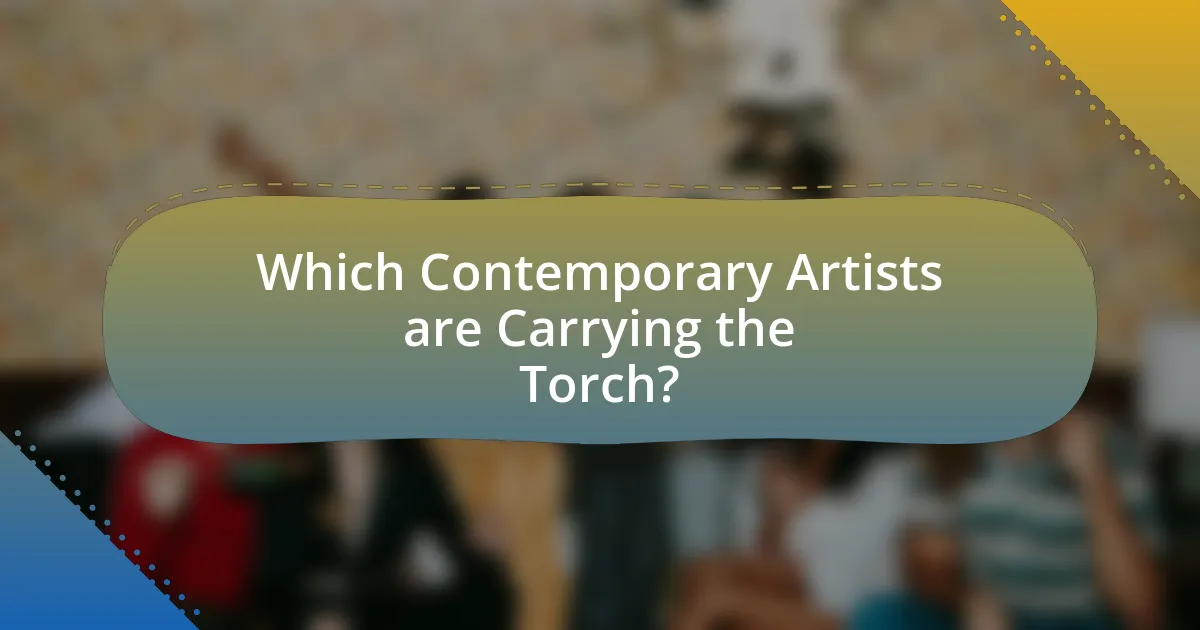
Which Contemporary Artists are Carrying the Torch?
Contemporary artists carrying the torch of protest music include Billie Eilish, Kendrick Lamar, and Hozier. Billie Eilish addresses issues such as mental health and climate change in her music, exemplified by her song “All the Good Girls Go to Hell,” which critiques environmental negligence. Kendrick Lamar’s work, particularly in albums like “To Pimp a Butterfly,” tackles systemic racism and social injustice, making him a prominent voice in contemporary protest music. Hozier’s “Take Me to Church” critiques societal norms and discrimination, particularly against the LGBTQ+ community, reinforcing his role in this legacy. These artists continue the tradition of using music as a platform for social change and awareness.
What are the defining characteristics of modern protest music?
Modern protest music is characterized by its focus on social justice themes, emotional resonance, and a blend of diverse musical styles. This genre often addresses issues such as racial inequality, climate change, and political corruption, reflecting the urgent concerns of contemporary society. Artists like Hozier and Billie Eilish utilize personal narratives and relatable lyrics to evoke empathy and inspire action, making the music accessible and impactful. Furthermore, modern protest music frequently incorporates elements from genres such as hip-hop, folk, and pop, allowing for a wider reach and engagement with various audiences. The effectiveness of this music is evidenced by its ability to mobilize listeners, as seen in movements like Black Lives Matter, where songs became anthems for change.
How do contemporary artists address current social issues through their music?
Contemporary artists address current social issues through their music by using lyrics, themes, and collaborations that reflect societal challenges and advocate for change. For instance, artists like Kendrick Lamar and Billie Eilish tackle topics such as racial inequality and mental health, respectively, in their songs. Lamar’s “Alright” became an anthem for the Black Lives Matter movement, highlighting police brutality and systemic racism, while Eilish’s “Your Power” raises awareness about abuse and exploitation. These artists not only express their perspectives but also engage their audiences in conversations about these pressing issues, demonstrating the power of music as a tool for social commentary and activism.
What innovative techniques are used by today’s protest musicians?
Today’s protest musicians utilize innovative techniques such as social media engagement, multimedia performances, and collaborative songwriting to amplify their messages. Social media platforms allow artists to reach global audiences instantly, facilitating the rapid spread of protest songs and movements. For instance, artists like Hozier and Billie Eilish have effectively used platforms like Instagram and TikTok to share their music and connect with fans on social issues. Multimedia performances, which incorporate visual art, video projections, and interactive elements, enhance the emotional impact of their messages, as seen in the work of musicians like Janelle Monáe. Collaborative songwriting, often involving diverse voices and perspectives, fosters inclusivity and solidarity, exemplified by projects like the “Songs for Social Change” initiative, which brings together various artists to address pressing social issues. These techniques not only modernize protest music but also ensure its relevance in today’s socio-political landscape.
Who are the leading contemporary protest musicians?
The leading contemporary protest musicians include artists like Billie Eilish, Hozier, and Kendrick Lamar. Billie Eilish has addressed issues such as climate change and mental health in her music, notably in songs like “All the Good Girls Go to Hell.” Hozier’s “Take Me to Church” critiques societal norms and discrimination, particularly regarding LGBTQ+ rights. Kendrick Lamar’s work, especially in albums like “To Pimp a Butterfly,” tackles systemic racism and social injustice, making him a significant voice in modern protest music. These artists exemplify how contemporary musicians continue the legacy of using music as a platform for social change.
What messages do artists like Billie Eilish and Hozier convey in their work?
Artists like Billie Eilish and Hozier convey messages of vulnerability, social justice, and emotional authenticity in their work. Eilish often addresses themes of mental health, self-identity, and societal pressures, as seen in her song “Bellyache,” which explores guilt and moral conflict. Hozier, on the other hand, uses his music to comment on issues such as love, inequality, and spirituality, exemplified in “Take Me to Church,” which critiques institutionalized discrimination and promotes acceptance. Both artists utilize their platforms to challenge societal norms and encourage listeners to engage with complex emotional and social issues.
How do emerging artists contribute to the protest music scene?
Emerging artists contribute to the protest music scene by infusing fresh perspectives and innovative sounds that resonate with contemporary social issues. These artists often address themes such as racial injustice, climate change, and economic inequality in their lyrics, making their music relevant to current movements. For instance, artists like Billie Eilish and H.E.R. have used their platforms to amplify messages surrounding the Black Lives Matter movement, demonstrating the power of music as a tool for activism. Their engagement not only attracts younger audiences but also revitalizes the genre, ensuring that protest music remains a dynamic and evolving form of expression.
What platforms do contemporary artists use to promote their messages?
Contemporary artists use social media platforms, streaming services, and digital art spaces to promote their messages. Social media platforms like Instagram, Twitter, and TikTok allow artists to reach wide audiences quickly, facilitating engagement and interaction. Streaming services such as Spotify and Apple Music provide a platform for artists to distribute their music and share their messages through lyrics and accompanying visuals. Additionally, digital art spaces like Behance and DeviantArt enable artists to showcase their work and connect with communities that share similar values. These platforms have become essential tools for contemporary artists to amplify their voices and advocate for social change.
How has social media changed the landscape of protest music distribution?
Social media has revolutionized the distribution of protest music by enabling artists to reach global audiences instantly and bypass traditional gatekeepers. Platforms like Twitter, Facebook, and Instagram allow musicians to share their messages and songs directly with listeners, facilitating rapid dissemination during social movements. For instance, during the Black Lives Matter protests, artists such as Janelle Monáe and Killer Mike utilized social media to promote their protest songs, resulting in millions of streams and shares within days. This shift has democratized music distribution, allowing diverse voices to emerge and engage with social issues without relying on record labels or mainstream media.
What role do live performances play in the effectiveness of protest music?
Live performances significantly enhance the effectiveness of protest music by fostering a communal experience that amplifies the message and emotional impact of the songs. When artists perform live, they create an immediate connection with the audience, allowing for collective expression and solidarity around shared social issues. Historical examples, such as the 1969 Woodstock Festival, illustrate how live performances can mobilize large groups and inspire activism, as the event became a symbol of counterculture and anti-war sentiment. Additionally, studies show that live music can evoke stronger emotional responses, making the messages of protest songs more resonant and memorable for listeners.
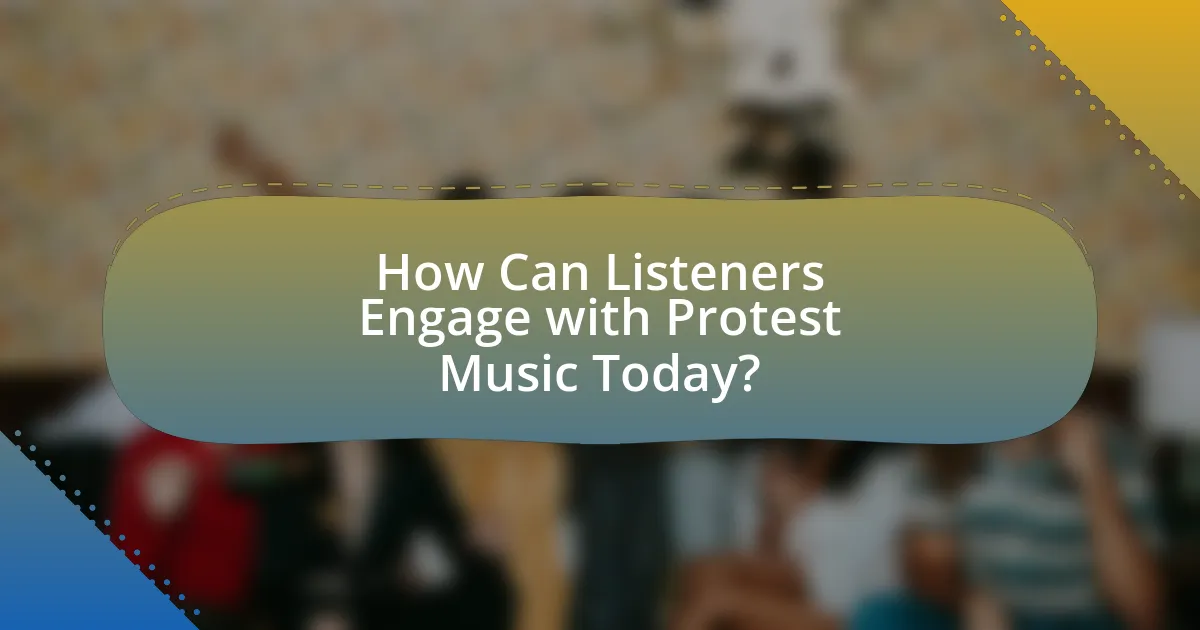
How Can Listeners Engage with Protest Music Today?
Listeners can engage with protest music today by actively seeking out and sharing songs that address social and political issues. This engagement can occur through streaming platforms, social media, and live performances, where listeners can amplify the messages of contemporary artists who continue the legacy of protest music. For instance, artists like H.E.R. and Billie Eilish use their platforms to raise awareness about racial injustice and climate change, respectively, encouraging listeners to participate in movements and discussions surrounding these topics. By attending concerts, participating in online discussions, and using music as a tool for activism, listeners can contribute to the ongoing dialogue and impact of protest music in contemporary society.
What are effective ways to support protest music artists?
Effective ways to support protest music artists include purchasing their music, attending their live performances, and promoting their work on social media platforms. By buying music directly from artists, fans ensure that a larger portion of the revenue goes to the creators, which is crucial for independent artists. Attending live shows not only provides financial support but also helps build a community around the message of the music. Promoting their work on social media amplifies their reach, allowing more people to engage with their messages and potentially leading to increased sales and visibility. According to a 2021 report by the Music Industry Association, independent artists who receive direct support from their audience see a 30% increase in overall revenue, highlighting the importance of fan engagement in sustaining protest music.
How can listeners participate in movements inspired by protest music?
Listeners can participate in movements inspired by protest music by actively engaging in social and political activism that aligns with the themes of the music. This can include attending protests, sharing information on social media, and supporting organizations that advocate for the causes highlighted in the songs. For example, during the Black Lives Matter movement, many listeners used protest songs to amplify their voices and mobilize support, demonstrating the direct impact of music on social movements. Additionally, purchasing music from artists who focus on social justice can provide financial support to those causes, further solidifying the connection between listeners and the movements they inspire.
What resources are available for discovering new protest music?
Streaming platforms like Spotify and Apple Music offer curated playlists specifically for protest music, allowing users to discover new tracks and artists. Additionally, websites such as Bandcamp and SoundCloud feature independent artists who often create protest music, providing a platform for emerging voices. Social media platforms, particularly Twitter and Instagram, serve as valuable resources where artists share their work and engage with audiences about social issues. Music blogs and online magazines, such as Pitchfork and NPR Music, frequently highlight new protest songs and artists, offering reviews and recommendations. These resources collectively facilitate the discovery of contemporary protest music, reflecting ongoing social movements and cultural dialogues.
How can protest music inspire personal action and change?
Protest music can inspire personal action and change by resonating emotionally with listeners and motivating them to engage in social and political movements. For instance, songs like “Fight the Power” by Public Enemy have historically galvanized individuals to confront systemic injustices, leading to increased activism and participation in protests. Research indicates that music can enhance group identity and solidarity, which are crucial for mobilizing collective action. A study published in the Journal of Social Issues found that exposure to protest music significantly increased participants’ willingness to engage in activism, demonstrating its effectiveness as a catalyst for personal and societal change.
What steps can individuals take to amplify the messages of protest music?
Individuals can amplify the messages of protest music by actively sharing the music through social media platforms, organizing community listening events, and engaging in discussions about the themes presented in the songs. Sharing music on platforms like Twitter, Instagram, and TikTok can reach a wider audience, as these platforms have millions of users who can engage with the content. Organizing community events, such as open mic nights or listening parties, fosters a collective experience that encourages dialogue about social issues addressed in the music. Engaging in discussions, whether online or in person, helps to contextualize the messages and connect them to current events, thereby enhancing their relevance and impact.
How can communities come together through protest music initiatives?
Communities can come together through protest music initiatives by fostering collective identity and shared purpose among individuals. These initiatives often involve collaborative songwriting, performances, and events that unite diverse groups around common social or political issues, such as civil rights or environmental justice. For instance, the “Songs of Protest” movement in the 1960s, which included artists like Bob Dylan and Joan Baez, galvanized communities to advocate for change, demonstrating how music can serve as a powerful tool for mobilization and solidarity. Additionally, contemporary artists continue this legacy by using platforms like social media to reach wider audiences, encouraging participation and engagement in social movements, thereby reinforcing community bonds through shared musical experiences.

